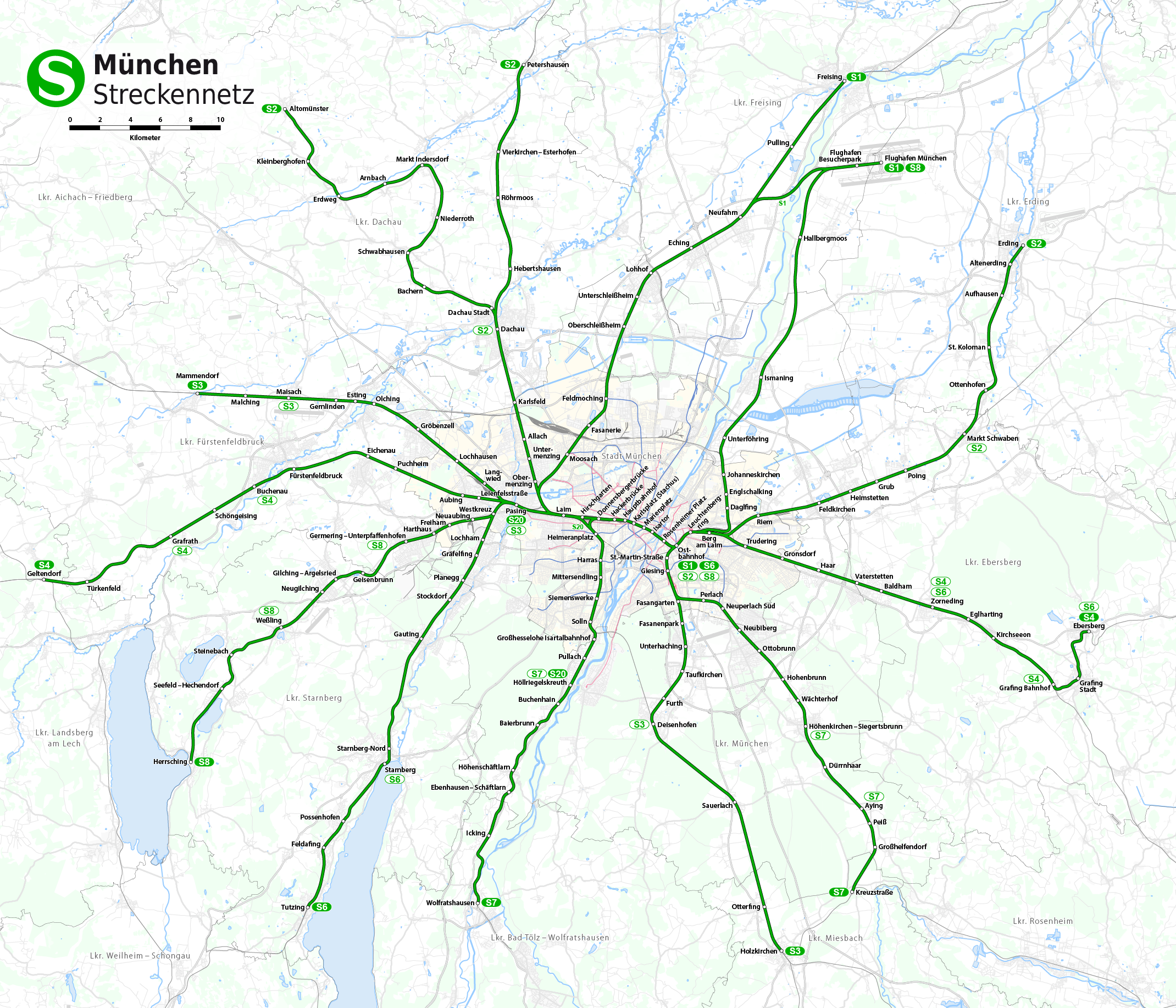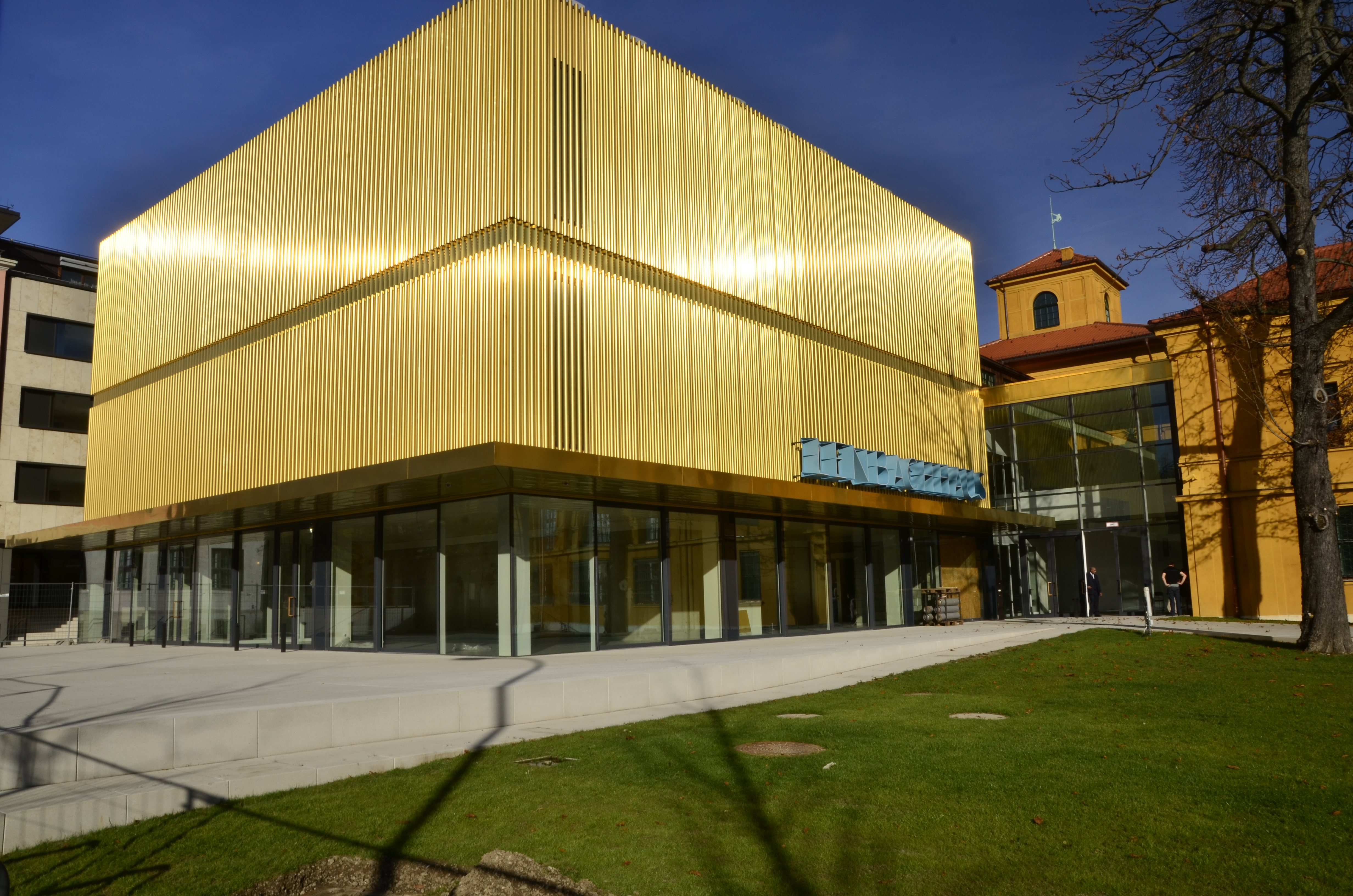|
Stammstrecke 2 (Munich U-Bahn)
The Stammstrecke 2 of the Munich U-Bahn is one of three main routes in the subway network of the Bavarian capital Munich. It runs from north to south, as well as east, and is currently operated by the underground U1 and U2 lines. Since 12 December 2011, the U7 line runs during high traffic times and since 15 December 2013 the U8 line assists on Saturdays. The U1 and U2 lines only run together on one route, in the central inner city area, before and after that, they are branched away from each other. The main line 2 has a total length of 33.8 kilometers and 38 underground stations. It runs exclusively in the city of Munich and completely in the tunnel. The construction of the Stammstrecke 2 began in 1971. In October 1980 the first section was opened between Scheidplatz and Innsbrucker Ring. In the following years, eight route extensions were carried out. The current expansion state was achieved in 2004. Further construction is possible, but not planned at the moment. History ... [...More Info...] [...Related Items...] OR: [Wikipedia] [Google] [Baidu] |
Munich Subway DF
Munich ( ; german: München ; bar, Minga ) is the capital and most populous city of the German state of Bavaria. With a population of 1,558,395 inhabitants as of 31 July 2020, it is the third-largest city in Germany, after Berlin and Hamburg, and thus the largest which does not constitute its own state, as well as the 11th-largest city in the European Union. The city's metropolitan region is home to 6 million people. Straddling the banks of the River Isar (a tributary of the Danube) north of the Bavarian Alps, Munich is the seat of the Bavarian administrative region of Upper Bavaria, while being the most densely populated municipality in Germany (4,500 people per km2). Munich is the second-largest city in the Bavarian dialect area, after the Austrian capital of Vienna. The city was first mentioned in 1158. Catholic Munich strongly resisted the Reformation and was a political point of divergence during the resulting Thirty Years' War, but remained physically unto ... [...More Info...] [...Related Items...] OR: [Wikipedia] [Google] [Baidu] |
Freising
Freising () is a university town in Bavaria, Germany, and the capital of the Freising ''Landkreis'' (district), with a population of about 50,000. Location Freising is the oldest town between Regensburg and Bolzano, and is located on the Isar river in Upper Bavaria, north of Munich and near the Munich International Airport. The city is built on and around two prominent hills: the Cathedral Hill with the former Bishop's Residence and Freising Cathedral, and Weihenstephan Hill with the former Weihenstephan Abbey, containing the oldest working brewery in the world. It was also the location of the first recorded tornado in Europe. The city is 448 meters above sea level. Cultural significance Freising is one of the oldest settlements in Bavaria, becoming a major religious centre in the early Middle Ages. It is the centre of an important diocese. Some important historical documents were created between 900 and 1200 in its monastery: * Freising manuscripts written in Sl ... [...More Info...] [...Related Items...] OR: [Wikipedia] [Google] [Baidu] |
Munich Feldmoching Station
Munich-Feldmoching station is a station in the Feldmoching section of Munich District 24, Feldmoching-Hasenbergl. Two rail lines serve the station, S-Bahn line and U-Bahn line . S-Bahn station Feldmoching station is on the Munich–Regensburg railway. A single track branch connects to the Munich North Ring, leading to the Munich North marshalling yard. This runs directly to the south, while the main line runs to the southwest. On 3 November 1858, the Royal Bavarian Eastern Railway Company opened the line between Munich and Landshut. A year later, the line was extended to Regensburg. The station was opened (in the then independent municipality) of Feldmoching in 1867. On 3 November 1891 the line was duplicated from Feldmoching to Lohhof. After 28 September 1892, the line south of Moosach was relocated, creating a double-track line to Munich Central Station (german: Hauptbahnhof). On 28 September 1925, Feldmoching station was electrified as part of the section from Munich to ... [...More Info...] [...Related Items...] OR: [Wikipedia] [Google] [Baidu] |
Munich Subway Messestadt West
Munich ( ; german: München ; bar, Minga ) is the capital and most populous city of the German state of Bavaria. With a population of 1,558,395 inhabitants as of 31 July 2020, it is the third-largest city in Germany, after Berlin and Hamburg, and thus the largest which does not constitute its own state, as well as the 11th-largest city in the European Union. The city's metropolitan region is home to 6 million people. Straddling the banks of the River Isar (a tributary of the Danube) north of the Bavarian Alps, Munich is the seat of the Bavarian administrative region of Upper Bavaria, while being the most densely populated municipality in Germany (4,500 people per km2). Munich is the second-largest city in the Bavarian dialect area, after the Austrian capital of Vienna. The city was first mentioned in 1158. Catholic Munich strongly resisted the Reformation and was a political point of divergence during the resulting Thirty Years' War, but remained ph ... [...More Info...] [...Related Items...] OR: [Wikipedia] [Google] [Baidu] |
Munich Subway Trudering
Munich ( ; german: München ; bar, Minga ) is the capital and most populous city of the States of Germany, German state of Bavaria. With a population of 1,558,395 inhabitants as of 31 July 2020, it is the List of cities in Germany by population, third-largest city in Germany, after Berlin and Hamburg, and thus the largest which does not constitute its own state, as well as the List of cities in the European Union by population within city limits, 11th-largest city in the European Union. The Munich Metropolitan Region, city's metropolitan region is home to 6 million people. Straddling the banks of the River Isar (a tributary of the Danube) north of the Northern Limestone Alps, Bavarian Alps, Munich is the seat of the Bavarian Regierungsbezirk, administrative region of Upper Bavaria, while being the population density, most densely populated municipality in Germany (4,500 people per km2). Munich is the second-largest city in the Bavarian dialects, Bavarian dialect area, ... [...More Info...] [...Related Items...] OR: [Wikipedia] [Google] [Baidu] |
Munich Trudering Station
Munich-Trudering station is an interchange station of the Munich S-Bahn and the Munich U-Bahn in the borough of Trudering-Riem in the Bavarian capital of Munich. History Trudering station was opened on 15 October 1871 at the same time as the Munich–Rosenheim railway. On 1 October 1938, Trudering station was renamed as ''Bahnhof München-Trudering'' (Munich–Trudering station). The former station building was demolished in the 1970s. On 28 May 1972 it has been integrated into the network of the Munich S-Bahn. Since 1979, the S-Bahn has had its own tracks through Trudering. The U-Bahn station was opened on Munich U-Bahn#U2, line U 2 under Truderinger Straße on 29 May 1999. During the construction of the tunnel on 20 September 1994, a cavity opened up below the road due to water penetration and a bus crashed in the resulting crater, leading to the death of two passengers and a construction worker. This delayed the completion of the tunnel to Riem and the station until 1999. ... [...More Info...] [...Related Items...] OR: [Wikipedia] [Google] [Baidu] |
Munich Riem Station
Munich-Riem station is an S-Bahn station and container terminal in the east of Munich in the district of Trudering-Riem on the Munich–Mühldorf railway in the German state of Bavaria. The station is served by the Munich S-Bahn and is classified by Deutsche Bahn as a category 4 station. History Riem station was established on 1 May 1871 with opening of the railway to Mühldorf. On 1 October 1938, it was renamed to München-Riem. Since 28 May 1972 passenger services to the station have only been operated by S-Bahn trains. Infrastructure Currently it is served by S-Bahn line S 2 (Erding–Petershausen). On the southern side of the station it is possible to transfer to bus routes 190 and 194 of the Münchner Verkehrsgesellschaft (Munich Transport Company, MVG). On the northern side, in the Dornach district, there is a bus stop served by MVV bus routes 263 and 264. It does not have disabled access. The station has a 210 meter long central platform and a 219 m long side platfor ... [...More Info...] [...Related Items...] OR: [Wikipedia] [Google] [Baidu] |
Munich S-Bahn
The Munich S-Bahn (german: S-Bahn München) is an electric rail transit system in Munich, Germany. "S-Bahn" is the German abbreviation for ''Stadtschnellbahn'' (literally, "urban rapid rail"), and the Munich S-Bahn exhibits characteristics of both rapid transit and commuter rail systems. The Munich S-Bahn network is operated by S-Bahn München, a subsidiary of DB Regio Bayern, which is itself a subsidiary of the German national railway company, Deutsche Bahn. It is integrated into the Munich Transport and Tariff Association (''Münchner Verkehrs- und Tarifverbund'', MVV) and interconnected throughout the city with the locally owned Munich U-Bahn. Today, the S-Bahn covers most of the populated area of the Munich metropolitan area of about 2.7 million inhabitants. The Munich S-Bahn was established on 28 May 1972. It was intended as part of the scheme to provide an adequate transport system during the 1972 Summer Olympics held in Munich by connecting the pre-existing suburban rail s ... [...More Info...] [...Related Items...] OR: [Wikipedia] [Google] [Baidu] |
Städtische Galerie Im Lenbachhaus
The Lenbachhaus () is a building housing an art museum in Munich's ''Kunstareal''. The building The Lenbachhaus was built as a Florentine-style villa for the painter Franz von Lenbach between 1887 and 1891 by Gabriel von Seidl and was expanded 1927–1929 by Hans Grässel and again 1969–1972 by Heinrich Volbehr and Rudolf Thönnessen. Some of the rooms have kept their original design. The city of Munich acquired the building in 1924 and opened a museum there in 1929. The latest wing was closed to the public in 2009 to allow the expansion and restoration of the Lenbachhaus by Norman Foster; the 1972 extension was demolished to make way for the new building. The museum reopened in May 2013. The architect placed the new main entrance on Museumsplatz in front of the Propylaea. The new facade, clad in metal tubes made of an alloy of copper and aluminum, will weather with time. The gallery The gallery contains a variety of works by Munich painters and contemporary artists, in ... [...More Info...] [...Related Items...] OR: [Wikipedia] [Google] [Baidu] |
Königsplatz, Munich
Königsplatz (, ''King's Square'') is a square in Munich, Germany. Built in the style of European Neoclassicism in the 19th century, it displays the Propyläen Gate and, facing each other, the Glyptothek (archeological museum) and the Staatliche Antikensammlungen (art museum). The area around Königsplatz is home to the Kunstareal, Munich's gallery and museum quarter. Architecture The square was designed as part of the representative boulevard Brienner Straße by Karl von Fischer working for Crown Prince Ludwig of Bavaria and laid out by Leo von Klenze. Fischer modeled the Königsplatz on the Acropolis in Athens. The concept was classical rigor embedded in living green, and so an expression of urban ideas of Ludwig I. who wanted to see cultural life, civic ideals, Catholic Christianity, royal administration and the military all together and embedded in green. Klenze framed the square with the Glyptothek and the Propylaea (created as memorial for the accession of Otto of ... [...More Info...] [...Related Items...] OR: [Wikipedia] [Google] [Baidu] |





